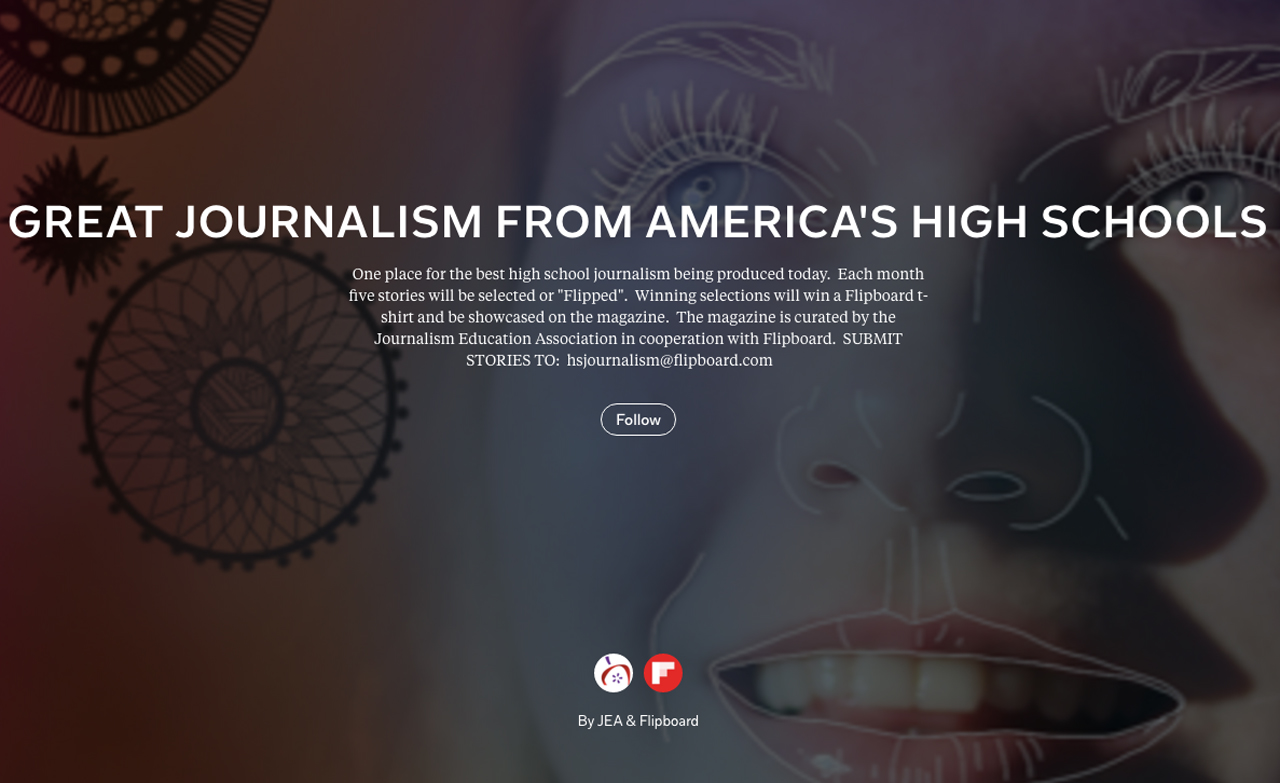In just six months, an innovative partnership between Flipboard and the Journalism Education Association has led to 100 new pieces of digital journalism by high school students and more than 2,500 followers to a digital magazine to showcase the best scholastic journalism in the country.
“It was exciting to get published by a broader national organization and a good way to see what other high school students are writing,” Nova Meurice, executive editor of The Little Hawk, said.

Nova Meurice getting her Flipboard t-shirt and certificate after being selected for publication. Photo by Jonathan Rogers
The magazine was presented at the National Council of English Teachers, and this summer it will be used at the International Society of Technology Educators as an example of what can be done in high school classes.
“The feedback we’ve gotten from educators and those interested in digital media initiatives has been tremendously positive,” said Megan Fromm, JEA Educational Initiatives Director. “I think people are surprised to see the kind of quality digital journalism high school students can produce. We hope this continued exposure further empowers students and creates buy-in from both media professionals and educators—we always need more collaboration with anyone who is willing to support high school journalists.
Flipboard sees great potential in the magazine, as well with the push for non-fiction in the classroom and more schools going one-to-one with tablets for all students.
Students submit entries to [email protected] where a team of judges selects entries to be published based on newsworthiness, journalistic style, going beyond informational, use of multimedia elements and technical merit or grammar. Stories in the magazine range from features to in-depth news to broadcast to photos to podcasts. Winning student journalists receive a Flipboard t-shirt and a certificate.
Q&A
Mia Quagliarello, who works with content and community at Flipboard, discussed the project and its benefits.
What ways do you see teachers and students being able to use the magazine?
We see it as a source of inspiration for students and teachers around the country, to get ideas for new stories, to see what peers are up to and to help high school journalism communities learn from each other. For those of us no longer in school, the magazine is a celebration and showcase of some of the best high school journalists in America — an incubator for our nation’s young talents.
How does Flipboard help showcase articles versus just a web search or other ways students process news?
It’s a fast, efficient and fun way to quickly research any story you’re writing about. Type a keyword or topic into Flipboard’s search box —for example, “bullying”— and you can quickly get a flippable ‘magazine’ out of the search results. There’s no need to click a bunch of separate links and have a million tabs open to read or save stories. This also works for hashtags on social media. For example, on Flipboard on your phone or tablet, try searching for a hashtag like #BlackLivesMatter, then going to social media results and selecting “Twitter.” You’ll be able to quickly flip through all the social media updates with this Twitter tag on Flipboard. Then, after finding stories for your reference or research, you can collect them into Flipboard Magazines, which can be public or private. A magazine lets anyone tell a narrative, share a perspective or simply showcase their passions and interests in a way that’s organized, beautiful and easy to read.
Anything you have learned from the selection of high school articles featured in the magazine?
Student journalists are great at using digital technologies to tell their school stories. Those stories that use video come alive and have a voice in a way that just using the written word cannot.
Any advice to those who are submitting?
There are so many rich stories to tell inside of a school. Spend less time looking at stories that happen outside of school and look more to your fellow students and teachers for truly original journalism. The best stories we have seen so far are stories about how things are happening to or with their classmates. These campus stories are so thoughtful.
Jonathan Rogers is a journalism adviser for Iowa City High School and serves as a Master Journalism Educator. He is the president of the Iowa High School Press Association and was voted IHSPA Journalism Teacher of the Year in 2015. He also works as the JEA Professional Outreach Chair and is a Dow Jones Distinguished Adviser.


